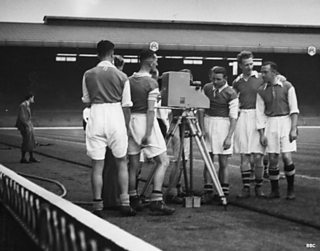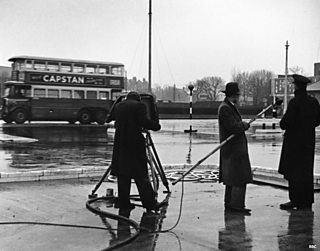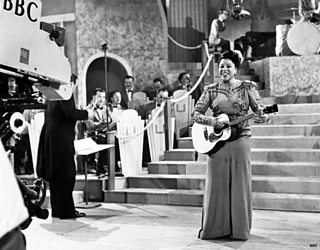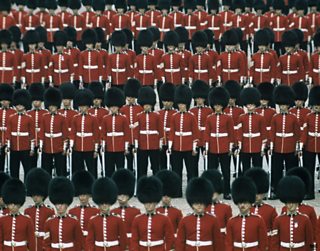Coming to You Live - The Origins of Outside Broadcast Television
Andrew Martin
�������� Genome

�������� technicians set up one of the three cameras used to cover the 1937 Coronation procession - the first true �������� television outside broadcast
Television outside broadcasts began with a bang on 12 May 1937, with the of King George VI and Queen Elizabeth.
Although the coverage was limited to a group of three cameras on Apsley Gate, at the corner of Hyde Park, it was a start – and was followed by an ever-widening range of outside broadcasts over the next two years, before television closed down on the eve of the World War Two.
�������� Television had been transmitting as a full service since , and until that point, broadcasts emanated from the studios at Alexandra Palace or its grounds - from the terrace of the Palace and parts of Alexandra Park. The Coronation was the first time a transmission was achieved at a real distance from �������� TV's headquarters.
To be strictly accurate however, even these experiments were not the first television outside broadcasts. As with many innovations, it comes down to "it depends what you mean by..." John Logie Baird’s experiments with 30-line television, beginning in the early 1920s, included several attempts to televise outside the studio. In 1928 he produced a closed-circuit image of the musical comedy star Jack Buchanan on the roof of his premises in London’s Long Acre, and by 1931 a mobile transmitting van had been developed, allowing Baird to transmit from the finish line of the .

Some of the Arsenal team of 1937 inspect a television camera, in the days when it would have cost more than they did...
Sport was an obvious candidate for outside broadcasts – with tennis from the first to be seen, just a month after the Coronation. , and were also shown in time – although there was resistance from the Football League from the start to televising games, and apart from practice matches, the only football matches seen pre-war were the of 1938 and 1939. This, however, led to other events being covered more fully, including unusual sports like , archery and water sports, from locations such as and Hurlingham.
The 1937 Coronation was also not the only national event that television covered, and many of the pioneering subjects are still represented in the present era. For example , the , and the were seen on the small screen in the 1930s – and the latter was probably the first time the present Queen, then Princess Elizabeth, was seen on television.
Stage productions were another novel use for outside broadcasts. Most pre-war TV plays were remounted theatre productions, and most involved the cast of a current show coming into the studio to perform extracts. The first play to be televised from an actual theatre was Magyar Melody, on 27 March 1939, while Me and My Girl, the famous show that gave the world "The Lambeth Walk" was seen on 1 May. However, managements were nervous of the possibility of television taking away the potential audience for a play, and only a few shows were broadcast in this way.

One early 'interest' outside broadcast came from the bus depot at Chiswick in West London
Apart from sport, drama and national events, outside broadcasts were also used to show gardening, from the in the grounds of Alexandra Palace and at the , farming, with a series of broadcasts from a at Waltham Cross, and the workings of bus depots, the Post Office, the railways, the police, aerodromes – and many other locations. Quite early on came the first broadcasts from , and this became a regular feature of the summer months.
One of the more notable occasions (albeit unbilled) which outside broadcast television witnessed came in September 1938, when Prime Minister Neville Chamberlain began the modern phenomenon of shuttle diplomacy, flying between London and Germany to negotiate the . On two occasions �������� television cameras were at Heston aerodrome (not far from the present-day Heathrow airport) for his return.
Other outside broadcasts anticipated the impending war. As early as 1936 a "local" OB from the terrace of Alexandra Palace showed anti-aircraft guns in action (to the alarm of local residents), while in July 1939 a large display by various military forces and civilian auxiliaries was televised from Hyde Park.

Singer Adelaide Hall made several appearances at the RadiOlympia exhibition - this is from 1947, but her first was in 1939
By 1939 another tradition that had been established was television’s relationship with the RadiOlympia trade show. This exhibition, which was open to the public, was the showcase of the radio industry. It had received a shot in the arm in 1936 when it staged the first demonstrations of �������� high-definition TV, organised at very short notice to help sell stands at the event. The first primitive programmes by the Baird 240-line and Marconi-EMI 405-line systems were rushed into production, although at that year’s RadiOlympia, and 1937's, all content emanated from Alexandra Palace.
By 1938, facilities were put in place so that could be transmitted from a temporary studio at Olympia itself. One of the most popular features was , a regular morning programme during the exhibition. This was an early talent show in effect, a kind of Britain’s Got Talent of its age. There weren’t many big stars discovered as a result, though at least one 1939 contributor went on to have a career in showbusiness – at the time listed as Bruce Johnston, he became better known under the surname Forsyth.
Come and Be Televised was almost the last programme shown before the closedown of television on – it was followed by a Mickey Mouse cartoon before the unceremonious switch-off. When nearly seven years later, it began on an outside broadcast as well – with a 'local' OB of announcer Jasmine Bligh arriving at the doors of Alexandra Palace. And one of the first major television events post-war was also an outside broadcast – the Victory Parade.

Trooping the Colour has been a regular outside broadcast on television since 1937 - our picture shows part of the 1971 ceremony when the colour trooped was that of the 2nd Batallion Grenadier Guards
Television outside broadcasts became one of the major elements of the medium through the next 20 years, with sport and events, including the and the , the latter of which is generally recognised as the great turning point in the popularity of television. That event was also one of the highlights in the career of the broadcaster , who became the go-to man for commentary on state occasions, and many other outside broadcasts great and small.
In the years since, outside broadcasts have become a standard part of the television palette, with sport and great state occasions featured alongside concerts from the to . Arguably however, outside broadcasts reached their zenith in the 1960s – with satellite broadcasting allowing everything into our homes, from the to the coverage of the space programme – must be the ultimate OB – as well as occasions like the and .
In the early days of television when most programmes were live, the outside broadcast was the epitome of television’s great selling point – that it could show you something happening far away, at the moment it was happening. That ability is something we rarely appreciate nowadays – but it still has to be admitted that some of the most compelling and world-changing events of recent years would have been very different in our memories had television not been there to share them with us.
